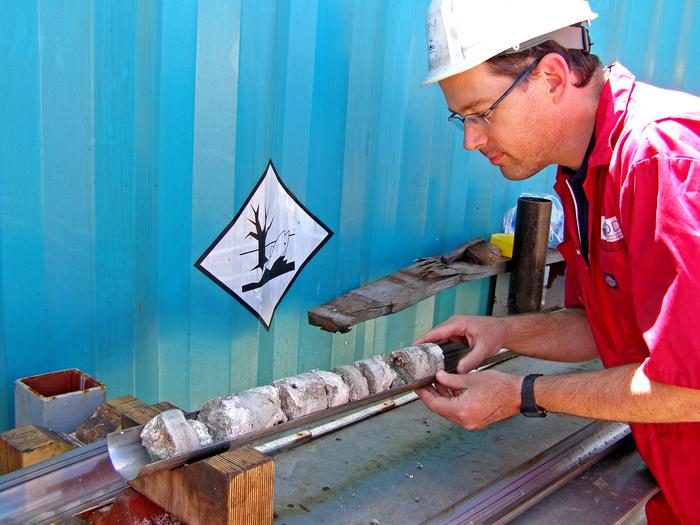New research spearheaded by the University of Sydney offers groundbreaking insight into the resilience and vulnerabilities of the Great Barrier Reef in the face of rapidly rising sea levels driven by climate change. This comprehensive study, published in the esteemed journal Nature Communications, methodically unpacks how past reef systems endured and ultimately succumbed to environmental pressures over ten millennia ago, providing a crucial analog for the threats modern reefs face today.
At the core of this research lies the examination of fossil coral reef cores extracted from beneath the Great Barrier Reef’s shelf edge. These geological samples, comprising fossil coral, algae, and sedimentary deposits, serve as a time capsule chronicling the reef’s response to environmental forces during a critical period known as Meltwater pulse 1B, approximately 11,450 to 11,100 years ago. This era was characterized by a rapid rise in global sea levels associated with deglaciation processes marking the end of the last ice age.
Professor Jody Webster, leading this multidisciplinary effort within the School of Geosciences at the University of Sydney, highlights that the ancient Reef 4—often referred to as the proto-Great Barrier Reef—shared many morphological and ecological characteristics with today’s reef system. Through precise radiometric dating and sedimentological analysis, the team was able to reconstruct sea-level fluctuations and reef growth patterns with remarkable resolution, challenging earlier assumptions about the magnitudes of sea level rise during this time.
Contrary to prior data from Barbados suggesting sea levels rose at an astonishing 40 millimeters per year during Meltwater pulse 1B, Webster’s team found that rise rates were in fact considerably lower, averaging between three to five millimeters annually. This revelation not only recalibrates our understanding of postglacial sea-level dynamics but also repositions the Great Barrier Reef’s historical responses within a framework more relevant to contemporary change.
One of the pivotal conclusions of this study is that Reef 4’s eventual collapse was not solely attributable to rapid sea-level rise. Instead, it was the interplay of elevated water temperatures, deteriorating water quality, and other climate-induced environmental stressors combined with sea-level changes that led to the reef’s demise. During this critical window toward the end of the last glaciation, these compounded pressures surpassed the thresholds of reef ecosystems, driving ecological restructuring.
Fascinatingly, the transition period following Reef 4’s decline saw the reef ecosystem migrate landward over the course of one to two thousand years, eventually establishing the modern Great Barrier Reef. This process underscores the dynamic nature of coral reef habitats and their capacity for migration in response to long-term environmental forcing, albeit over geological timescales significantly longer than those experienced today.
The methodology underpinning this research involved deep-sea drilling operations conducted by the International Ocean Drilling Program (IODP), extracting cores from depths of 40 to 50 meters beneath the current reef shelf edge. The recovered cores underwent extensive paleontological and geochemical analyses, providing high-resolution data on past coral species composition, growth rates, and reef habitat structures. These findings elucidate the conditions in which reef systems can thrive, and equally, the environmental thresholds beyond which they falter.
Professor Webster emphasizes how the modern Great Barrier Reef confronts a suite of unprecedented stressors beyond sea-level rise, including frequent marine heatwaves, widespread coral bleaching, and increased sediment and nutrient influx from coastal development. The synergistic effect of these stressors, layered atop rapidly rising seas, compounds the existential threat facing one of the world’s most iconic marine ecosystems.
This research offers a sobering forecast: while the reef ecosystem will not vanish altogether, its structure, species composition, and ecological functions are poised to evolve considerably. We may witness simplified reef architectures dominated by hardier, less structurally complex coral species displaced by more fragile varieties unable to cope with chronic environmental stress.
Beyond ecological implications, the study highlights the value of deep-time paleoclimatic records, which extend far beyond the limited temporal range of instrumental observations. By comparing ancient reef responses to rapid sea-level and temperature changes with present-day conditions, researchers can refine models predicting future reef trajectories under climate change scenarios.
Interdisciplinary collaboration was central to the study’s success, involving scientists from institutions such as the University of Tokyo, Australian National University, Nagoya University, the University of Granada, and Aix-Marseille University. Their collective expertise in marine geology, paleoecology, and climate science was integral to interpreting the nuanced signals encoded in the reef cores.
The research ultimately serves as a pivotal benchmark in understanding how coral reef ecosystems withstand and adapt to rapid environmental changes. As the Great Barrier Reef confronts an uncertain future in a warming world, lessons derived from its geological past may inform conservation strategies aiming to preserve reef resilience and biodiversity over coming decades.
Subject of Research:
Not applicable
Article Title:
Constraints on sea-level rise during meltwater pulse 1B from the Great Barrier Reef
News Publication Date:
2-Jun-2025
Web References:
http://dx.doi.org/10.1038/s41467-025-59858-0
References:
Not provided
Image Credits:
International Ocean Drilling Program
Keywords:
Marine geology, Marine biology, Marine ecology, Oceans, Coral reefs, Coral bleaching




